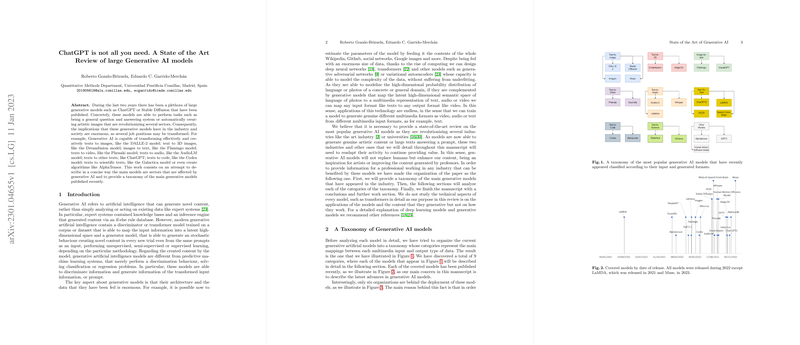An Analytical Overview of the State-of-the-Art in Large Generative AI Models
The paper "ChatGPT is not all you need. A State of the Art Review of Large Generative AI models," by Roberto Gozalo-Brizuela and Eduardo C. Garrido-Merchán, undertakes a comprehensive examination of large-scale generative AI models that have proliferated in recent years. These models, exemplified by ChatGPT and Stable Diffusion, are reshaping numerous sectors by automating complex tasks ranging from text-to-image creation to generating cohesive narrative constructs in dialogue. This paper provides a critical exploration of their structure, capabilities, and the significant shift they impose on industry practices.
Taxonomy and Core Capabilities
Generative AI models are primarily designed to create novel content, distinguished from traditional predictive machine learning models. The work creates a taxonomy of these models based on input-output mappings, like text-to-image or image-to-text, emphasizing the diversity and specialization of contemporary AI technologies. The paper classifies nine key categories and meticulously details quintessential models within each, such as DALL-E 2, DreamFusion, Flamino, and AudioLM.
Key among these are the text-to-image models like DALL-E 2 and IMAGEN, which employ advanced neural networks such as CLIP for generating relevant artworks based on textual descriptions. Their judicious use of LLMs for encoding text underscores the paramount role of language understanding in creative AI processes. Meanwhile, models like Stable Diffusion adopt unique architectures for greater computational efficiency by operating within latent spaces rather than pixel spaces.
Text-to-3D models such as DreamFusion harness pretrained diffusion models for 3D synthesis from textual inputs, extending the potential applications into domains like gaming and augmented reality. Moreover, the paper highlights the evolutionary leap in text-to-video models, evidenced by Google's Phenaki, which integrates video generation with narrative coherence despite the absence of real-time data processing.
Implications and Challenges
The analysis in this paper also contemplates the profound implications of these AI models across various sectors, such as art, academia, and software development. It posits that while AI will not replace human creativity, it holds significant potential to augment productivity by automating routine creative processes, thereby acting as a tool for professional enrichment.
However, it also presents challenges inherent in deploying generative AI at scale. Key issues include data diversity, computational demands, biases within training datasets, and the ethical use of AI-generated content. For instance, while models such as Minerva and Galactica promise advancements in scientific text generation and mathematical problem solving, the accuracy and contextual fidelity remain areas for enhancement. Moreover, the paper surfaces concerns about the misuse of AI models in generating misleading content, emphasizing the necessity for robust ethical guidelines and control mechanisms.
Towards Future Development
The paper provides a speculative lens on the future trajectories of generative AI. Advancements in model accuracy, efficiency in computation, bias mitigation, and the synthesis of new algorithmic discoveries will be critical areas for research. Models like AlphaTensor, which propose innovative algorithms autonomously, highlight an intriguing dimension where AI could contribute to foundational computational methods. Meanwhile, the expansion of generative capabilities into multimodal formats through architectures like GATO signals the dawn of more versatile AI systems capable of complex task integration.
The compilation by Gozalo-Brizuela and Garrido-Merchán serves as a foundational discourse that encourages further scholarly inquiry and pragmatic assessments of generative models' impacts. By delineating a broad spectrum of AI's capabilities and limitations, it sets the stage for continued exploration and refinement in this rapidly evolving field. In summary, the paper enunciates both the promise and the responsibility that accompany the deployment of large-scale generative AI, marking a pivotal moment for computational innovation and its societal integration.
